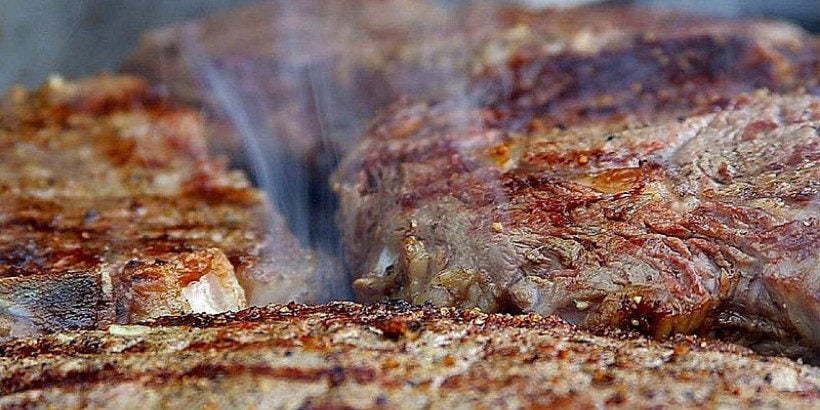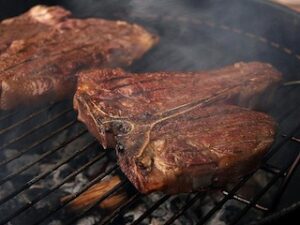How to Cook the Perfect, Tender Grass-Fed Steak

Summertime is here, which means it’s officially grilling season! Whip up a delicious grass-fed steak at your next BBQ to support small-scale farmers, help protect the environment, and give your guests a meal they’re going to be talking about all summer.
The following is a collection of recipes from cookbooks by Shannon Hayes, author of Radical Homemakers, Farmer and the Grill, and The Grassfed Gourmet.
Cooking A Perfect Grass-Fed Steak
 The simplest, most commonly heard distinction made between grassfed and factory-farmed meat is that grassfed is leaner. As we’ve just seen, that is not always the case. The real difference lies in the fact that, by virtue of a beef animal’s active and healthy life, there is true muscle integrity in the meat. This is wildly different from the feedlot animals, which get little or no exercise, resulting in more flaccid (and, hence less flavorful) cuts.
The simplest, most commonly heard distinction made between grassfed and factory-farmed meat is that grassfed is leaner. As we’ve just seen, that is not always the case. The real difference lies in the fact that, by virtue of a beef animal’s active and healthy life, there is true muscle integrity in the meat. This is wildly different from the feedlot animals, which get little or no exercise, resulting in more flaccid (and, hence less flavorful) cuts.
The Perfect Texture
This does not mean that grassfed steaks are less tender – on the contrary. Cooked more gently, grassfed meat is wonderfully tender. The healthy muscle texture does, however, mean that grassfed steaks will be more variable than grainfed meats. Taste and texture of steaks will vary based on breed, farming practices, pastures, and individual animal characteristics. Thus, the trick to cooking a delicious steak is to work with the variability and take advantage of that beautiful muscle quality.
We should be treating this meat as “tenderly” in the kitchen or on the grill as the farmers treated the animals in the fields. When cooking a grassfed steak, we want to achieve a delicious sear that creates a pleasant light crust on the exterior of the meat, then allow it to finish cooking at a much lower temperature; this allows the naturally-occurring sugars to caramelize on the surface, while protecting those muscle fibers from contracting too quickly. Tough grassfed steaks result from over-exposure to high heat, which causes the muscle fibers to contract tightly and become chewy and overly dry.
Cooking Grass-Fed Steak Indoors and Outdoors
Keeping these principles in mind, below are two techniques for cooking a fantastic steak, using the same seasonings. The first technique, taken from The Farmer and the Grill, is for working outdoors with open flames, my preferred method, YEAR ROUND.
The second technique is taken from my newest cookbook, Long Way on a Little: An Earth Lovers’ Companion for Enjoying Meat, Pinching Pennies and Living Deliciously. Much to my surprise, not every family on the North American continent has access to an outdoor grill – hard to believe! Thus, in an effort to include you in the thrill that comes from eating the best-tasting steak available, I’ve included an indoor steak recipe that guarantees your grassfed meat will remain tender and juicy. Enjoy!
The Best Grass-Fed Steak – Outdoors
Recipe adapted from Farmer and the Grill: A Guide to Grilling, Barbecuing and Spit-Roasting Grassfed Meat…and for saving the planet, one bite at a time, by Shannon Hayes
(The amount of seasoning you will use will vary based on the size of your steak. If it is close to one pound, use less. If it is closer to 2 pounds, use more.)
Ingredients
- 1-2 tablespoons coarse salt
- 1-2 teaspoons ground black pepper
- 1-2 cloves garlic, minced
- Either 1 sirloin, sirloin tip, tri-tip, top round or London Broil, rib eye, porterhouse, t-bone, top loin (NY Strip) or tenderloin (filet mignon) steak. Steaks should be at least 1 ¼ – 1 ½ inches thick.
Procedure
- Combine the salt, pepper and garlic in a small bowl. Rub the mixture into both sides of the steak, then allow the meat to come to room temperature while you prepare the grill.
- Start the grill and warm it until it is hot. If you are using a gas grill, turn off all but one of the burners once it has come up to temperature. If you are using charcoal, be sure all the coals have been raked to one side. Use the hand test: the grate will be hot enough when you can hold your palm 3-4 inches above the metal for no more than three seconds.
- Sear the steaks for 2-3 minutes on each side directly over the flame, with the lid down. Then, move the steaks to the part of grill that is not lit. Set the lid in place and allow the steaks to cook, without flipping them, until they reach 120-135 degrees**, about 10-20 minutes, depending on the size of the steak. Remove the steaks to a platter and allow them to rest a few minutes before serving.
The Best Grass-Fed Steak – Indoors
Recipe taken from Long Way on a Little: An Earth Lovers’ Companion for Enjoying Meat, Pinching Pennies and Living Deliciously, by Shannon Hayes
(The amount of seasoning you will use will vary based on the size of your steak. If it is close to one pound, use less. If it is closer to 2 pounds, use more.)
Ingredients
- 1-2 tablespoons coarse salt
- 1-2 teaspoons ground black pepper
- 1-2 cloves garlic, minced
- 2 tablespoons butter, tallow or rendered lamb fat
- Either 1 sirloin, sirloin tip, tri-tip, top round or London Broil, rib eye, porterhouse, t-bone, top loin (NY Strip) or tenderloin (filet mignon) steak. Steaks should be at least 1 ¼ – 1 ½ inches thick.
Procedure
- Combine the salt, pepper and garlic in a small bowl. Rub the mixture into both sides of the steak then allow the meat to come to room temperature.
- Preheat the oven to 200°, then heat a large cast iron skillet or other oven-proof skillet over a high flame. Once the skillet is so hot that you can see a little smoke rising off of it, add the butter or fat. Sear the steak for two minutes on each side.
- Turn off the flame, and insert an instant-read meat thermometer into the boneless edge of the steak – do not insert it into the top, as there is not enough thickness for the thermometer to take an accurate reading.
- Leaving the steak in the skillet, place it in the oven and allow it to finish cooking, about 10-20 minutes depending on the size of the cut, until the internal temperature reads 120-135°. Allow the meat to rest five minutes before carving and serving.
Weren’t aware that grassfed meats have different internal doneness temps than grainfed? Get a handy magnetic grassfed temperature guide, the Don’t Overdo It Magnet, from grassfedcooking.com. They’re inexpensive, and you can feel good about them, because they are made by a small, locally owned factory in my community.
Recommended Reads
Wild Flavors to Fire Up Your Grill: Foraging for Wood and Aromatics
Recent Articles
Introducing…your new favorite brunch dish! This whole broccoli frittata is packed with fresh, wildcrafted flavors that are bound to help you start your day off on the right foot. The following is an excerpt from The Forager Chef’s Book of Flora by Alan Bergo. It has been adapted for the web. RECIPE: Whole Broccoli Frittata…
Read MoreMany know the effects of catnip on our feline friends, but few realize that catnip has medicinal effects for humans. From stomach aches to reducing fevers, catnip is a versatile herb with many benefits. The next time you grow this plant for your cat you may end up taking a few cuttings for yourself! The…
Read MoreIt’s time to take control of your seeds and become a plant breeder! Saving your seed allows you to grow and best traditional & regional varieties, and develop more of your own. The following excerpt is from Breed Your Own Vegetable Varieties by Carol Deppe. It has been adapted for the web. Becoming A Plant…
Read MoreWondering where to forage for greens this spring? Look no further than hedges, which serve as natural havens for wild greens and herbs! The following is an excerpt from Hedgelands by Christopher Hart. It has been adapted for the web. Food from Hedges: Salads and Greens Let’s start by looking at all the wild foods…
Read MoreThere’s a whole new world out there when it comes to koji. It doesn’t matter if you’re making bread, cheese, or ice cream, koji helps you pump up the flavor! Growing Koji in Your Own Kitchen Koji, the microbe behind the delicious, umami flavors of soy sauce, miso, fermented bean sauce, and so many of…
Read More








